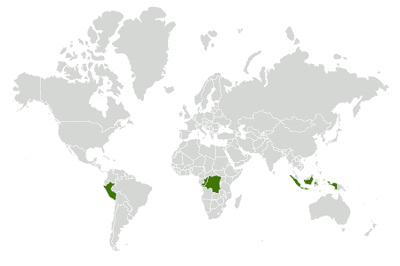FAO's work on peatlands
What is a peatland?
A peatland is an area of land with layers of accumulated organic material in the soil, in a state of decay. These layers, what is known as peatland, develop in waterlogged conditions. Peatlands represent the largest terrestrial carbon reserve per hectare. Damage to these fragile ecosystems, which work as a slow carbon sink and take thousands of years to form, causes major greenhouse gas emissions.
According to the latest global estimates, peatland drainage and fires are estimated to contribute at least 5 percent of global greenhouse gas emissions, contributing to climate change. Proper protection and restoration of peatland ecosystems support the adaptive capacity and climate change mitigation efforts, as well as maintain the production of other ecosystem services, such as reducing the risks of floods and fires.
Our contribution
FAO assists countries with peatland mapping, monitoring, and improved management, to support sustainable livelihoods, enhance environmental services, and reduce negative impacts, contributing to targets on better environment and better production. FAO supports countries in advancing sustainable, wet peatland management through support at the regional, national and field levels:
- Policies and governance such as integration of peatlands into national plans and reporting,
- Knowledge sharing and capacity development,
- Technical support, in particular focused on mapping and monitoring.
FAO works on projects covering different aspects of peatland management together with four countries: Indonesia, Peru, Democratic Republic of Congo and the Republic of Congo, in addition to other work at the global level. Peatlands are one of the key focus ecosystems of the UN Decade on Ecosystem Restoration 2021–2030.

The importance of peatlands
While peatlands cover a mere 3 percent of the earth’s ice-free land mass, they contain 30 percent of the world’s organic soil carbon, and may contain more carbon than the world’s forests and atmosphere combined.
About 169–180 countries, in all climatic zones, host peatlands, however, many lack useful peatland maps and assessment. Many initiatives, also with our support, are filling this gap.
Peatlands are becoming increasingly threatened due to drainage for agriculture, forestry and plantations, logging, grazing, and peat extraction for fuel. Peatlands also dry out and become greenhouse gas sources if their vegetation is altered. Peatland degradation threatens biodiversity, decreases water quality, causes land subsidence or lowering of the surface level, increases fire and flooding frequency, and other negative impacts on people, their livelihoods, and the environment.
As solutions, rewetting and sustainable, wet management of peatlands can help maintain peatland ecosystem services, improve local livelihoods, restore water quality, and assist with climate change mitigation and adaptation as well as disaster risk reduction.
Cases of peatland management
Informed assessment of peatland management practices is needed to understand the impacts of different peatland management on livelihoods as well as land subsidence, greenhouse gas emissions, water security and quality, biodiversity and other ecosystem services. Explore various case studies from around the world that describe practices related to rewetting, wet biomass production, degraded pasture restoration, forestry practices and fisheries. Please contact the FAO team, if you would like to share your case study.
Working with partners
FAO is a founding member of the Global Peatlands Initiative, which is comprised of over 40 authorities and institutions, working together on peatland conservation and sustainable management, with the goal to keep carbon in the soil rather than in the atmosphere, where it would contribute to climate change.
Interested in learning more and exchanging with online communities? Here you can join discussions about climate change and peatlands or their mapping and monitoring.
Contact us: [email protected]

